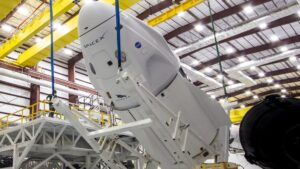“The flight readiness review was very successful. We only had one exception, which needs to be cleared up in the next few days,” said Kathy Lueders, NASA associate administrator for human exploration and operations, during a press conference after the review.
That exception involves an issue with loading liquid oxygen into the first stage of the Falcon 9 that results in more liquid oxygen being in the tank than expected. The error is relatively small: Bill Gerstenmaier, the longtime NASA official who is now a vice president for SpaceX, said the level of liquid oxygen in the tank was no more than about 10 centimeters higher than expected.
He said SpaceX discovered it during testing of a Falcon 9 first stage at the company’s McGregor, Texas, facility, when weather interrupted the usual loading process. “That gave us some insight that we don’t typically get, and we got to see that the amount of oxidizer that we had loaded into the tank was a little bit different than what we had analyzed it to be,” he said.
SpaceX will take the time to analyze the loading error, which Gerstenmaier said was common to all Falcon 9 rockets, to ensure the safety of the upcoming crewed launch. “I think in a normal program, this amount of difference wouldn’t matter to anyone, but in our world, we’re going to take the extra step and go review it, look at the consequences and what happens worst-case,” he said.
If that issue is resolved, SpaceX will go ahead with a static-fire test of the Falcon 9 first stage early April 17 at Kennedy Space Center’s Launch Complex 39A. The launch is scheduled for 6:11 a.m. Eastern April 22, with a backup launch date a day later. If the mission is delayed beyond April 23, the next opportunity to launch would be April 26.
Other preparations for the launch are proceeding normally. The astronauts that will fly the Crew-2 mission — NASA’s Shane Kimbrough and Megan McArthur, ESA’s Thomas Pesquet and JAXA’s Akihiko Hoshide — will arrive at KSC April 16 and go through a “dry dress rehearsal” of launch preparations two days later.
They will fly both a spacecraft and rocket that have been used before. The Crew Dragon spacecraft, called Endeavour, launched on the Demo-2 mission in May 2020, the first crewed Crew Dragon mission, while the Falcon 9 first stage previously launched the Crew-1 mission in November 2020.
“We had to do an extensive amount of work” to confirm both the Crew Dragon and Falcon 9 booster were safe for reuse on a crewed mission, said Steve Stich, manager of NASA’s commercial crew program. That also evaluated a number of upgrades to the vehicle, such as an improved battery system and changes to the abort thrusters that allow them to use more propellant and thus improve their performance.
“It was a series of upgrades to improve safety,” he said, “and having to make sure the structures, the component lifetimes were all within the certification and the qualification of those components.”
If Crew-2 does launch April 22, it will dock with the ISS at about 5:30 a.m. Eastern April 23. The Crew-1 spacecraft currently at the station would depart the station on the morning of April 28, splashing down at 12:40 p.m. Eastern that day in the Gulf of Mexico off the coast from Tallahassee, Florida.
Stich said NASA was working with the U.S. Coast Guard to prevent a repeat of the Crew-1 splashdown in August 2020, when dozens of private boaters swarmed the capsule after splashdown. More Coast Guard vessels will patrol the splashdown zone to keep other ships at a safe distance. “We don’t anticipate having that problem again.”



